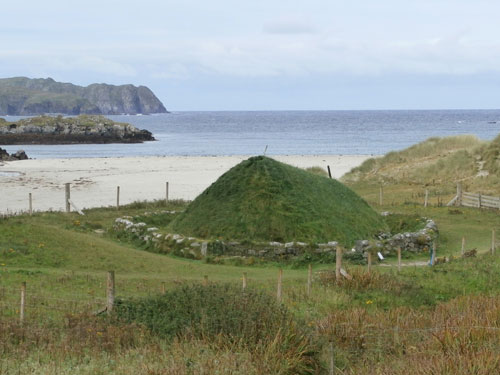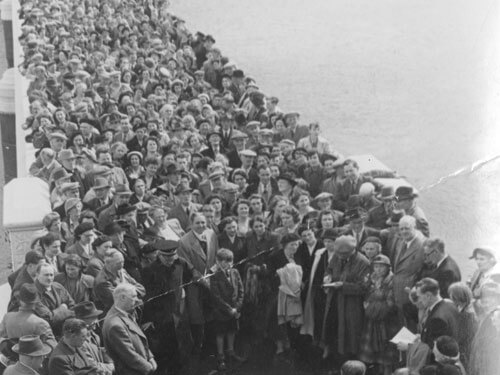THINGS TO DO
EAT OUT, WALK OR TAKE A OCEAN TRIP
Breathtaking views and brilliant experiences from the Bernera Bridge to Bosta beach, all on one island on the edge of the Atlantic.

Bernera Community Centre
The Community Centre in Breaclete is the island gathering place for clubs, sporting activities and events. The Community café, garden and Bernera Museum are also housed at the centre. The Hall is open all year (with limited opening hours during the winter months) and provides free parking, toilets (with disabled access, and the use of shower facilities for a nominal fee).
For more about the Bernera Community Centre and what it offers click here.
Islands of Adventure
Islands of Adventure is Great Bernera's only unique seafaring adventure. Our speciality is giving you an exhilarating once in a lifetime experience. Our high class speed boat along with breath-taking scenery and amazing wildlife is the most exciting way to explore this part of the Western Isles. While you cruise and experience the becuty of Great Bemera and its surrounding Islands, you then get into open waters and the Adventure begins.
For more information visit islands-of-adventure.co.uk


Dubh Thob Pontoons
Situated next to the Pier, in the beautiful and dramatic Black Bay in Kirkibost, Great Bernera, the new Dubh Thob Pontoons are a fantastic addition to the community resources. Offering short and long term berths with modern services, such as water and electricity, and support from a team of volunteers, these are useful for residents and visitors alike.
HISTORICAL SITES ON BERNERA
Bernera has a rich history that dates back to prehistoric times and there are various historical and archaeological sites dotted around the island that are worth visiting and make for a wonderful day out.
For more information and directions to the sites below, please visit the Bernera Museum’s website

Bosta Beach
Many a person has listed Bosta Beach as one of their favourites on Lewis. Compared to the vast expanses of the Uig beach, Bosta is modest in size, however the beautiful views, green meadow littered with wildflowers, white sand banks, clear blue waters and roaming Highland cattle make it a very special place. Also located at Bosta beach is the quaint, historic Iron Age house, a good-sized car park, public bins and toilet facilities, outdoor seating and picnic tables. The beach can be a hive of activity in the summer months, (so much so, that finding a parking spot can sometimes be difficult). Bosta beach has a lovely family atmosphere, is a favourite dog-walking area for many, and is also home to a stone walled cemetery which is still in use (please respect this and do not park here when there is a funeral). This is a popular beach for families, swimmers and kayakers, but be warned the waters can be chilly! : )

Bosta Iron Age House
In 1992 a severe storm exposed stone walls of an ancient village which had lain hidden under sand dunes at Bostadh Beach, (Bostadh means farm in Old Norse). In 1996 the site was excavated to reveal a well-preserved settlement of houses that dated back to the Late Iron Age (or Pictish Age) of 400-800AD. Located in an idyllic, small valley, with streams, a beautiful beach and rich fishing waters, Bostadh would have been a perfect home for these early dwellers. The excavation was recorded in detail and a footprint of the village was laid out, however the vulnerable structures themselves could not be preserved due to the process of erosion and sand build up. Again, they lie hidden beneath the sand, however, based on the original buildings, a life-size reconstruction of a period home was made on more secure ground, using the same techniques that were available at the time the original structures were created.
This delightful Iron Age house is open to visitors throughout the summer months and the gives fascinating insight into how early settlers lived. More information about the house, it's opening times and costs can be found on the Bernera Museum Website.

The Bernera Norse Mill
Located to the north east of Breaclete village. This good example of a Norse mill would have been used for centuries, providing a small community with a source of efficient waterpower, operated by the small stream issuing from a loch above the mill and controlled through a mill race channel (this is not currently in use).
The mill has been reconstructed by the Bernera Historical Society who reroofed it in 2018 with turf cut by local volunteers. It's a small bee-hive structure with two floors, milling on top and the water chase below. The original milling equipment can be seen inside the mill. Other earlier mill dams can still be seen at the loch above the mill when the water level is low.

Loch Risay Lobster Ponds
The lobster pond at Loch Risay is a wonderful example of Bernera’s fishing history. During the 1870’s, Murdo Morrison of Croir dammed this tidal sea loch to create the first (and largest) lobster pond on Bernera. The waters of Loch Roag yielded an abundance of lobsters, however, because local fishermen were getting poor returns for their live lobsters that were being sold to London by the ton, they came up with a solution. By storing their catches in these sheltered ponds, they could keep their lobsters safely, out of the way of stormy weather, and build up their stocks until the prices were higher. The pond at Risay was still in use until the 1950’s and due to excellent craftsmanship, the main structure is still working to this day.

The Bernera Stone Circle
Located on the southern slope of Cleitir Hill, just above the Bernera Bridge.
Overlooking the Bernera Bridge and narrows stand a small group of Lewisian Gneiss standing stones known as Callanish VII. The stone arrangement consists of three standing stones and a fourth recumbent stone which form part of a circular arc. There is parking next to the stones with a short, steep access path leading up to them.


The Bridge over the Atlantic
The Bernera Bridge is a lifeline to the island, providing a connection with mainland Lewis for supplies and commuting. Prior to its construction boats were used to transport people, livestock and goods to and from mainland Lewis. However, after WWI, the people of Great Bernera, realising how their relative isolation could negatively impact the future of their island, started a campaign for a permanent connection to the mainland. It was said that the spirited islanders apparently threatened to blow up the cliffs and create their own causeway, but thankfully before they did, in 1951 public funding was granted and construction began to build a bridge to span the narrows.
The bridge design was a breakthrough for British civil engineering at the time. It was the first of its kind in the UK to be built with pre-stressed concrete girders and utilised only a quarter of the steel required in conventional bridge building. The opening was a cheerful day with over 4000 people attending to take those first steps across the new bridge. But this is not the end of the story; ‘The Bridge Across the Atlantic’ as it was more affectionately known, was due a routine structural survey in 2020. Serious faults were discovered and a weight restriction of 7.5T was immediately placed on the bridge meaning the community had pull together to find different ways of collecting rubbish and delivering oil, gas and heavy building materials. Once again, the residents of Bernera waited with intrepidation to see if a new bridge would be funded. In 2021 funding was secured and work began in March 2021 to build a single span Delta bridge, capable of carrying 44 tonne loads. At a cost of close to £2,000,000 the bridge was officially opened to all vehicles on 15th December 2021. The ribbon was cut and once again a lively crowd gathered to cross over the Atlantic! The old bridge remains in place and is a popular venue for mackerel fishing in the summer months, or simply to take in the views.

Shieling Huts
Located above Tob Chèurabhagh, a bay at the southern end of Loch Roag
Shielings were moorland summer grazings for cattle. The shieling huts were small, simple dwellings made from stone, driftwood and turf and located within the shieling. They were usually occupied from May until the “flitting” in September. In early May the men of a village would go onto the moor to check and repair the huts. They would be joined by the women and children for one night before the men returned to the village to tend to crops or to travel away for summer work such as fishing. The women and children would spend the summer at the shielings tending the cattle and making cheese and butter. Peat cuttings would be used for the fire and evenings would be spent making music and story-telling.
The Clearances and ongoing changes in agricultural methods meant that the shieling tradition had generally ended by the close of the nineteenth century. In places it continued for longer and some modernised shieling huts are still used today during the peat cutting season and as summer retreats. Tob Cheurabhagh is no longer in use.

Bernera Riot Landmark Cairn
Located at the junction of the Tobson and Bosta roads.
This cairn, erected in 1992 is a memorial to the people of Bernera who, in 1874, rose in protest as a reaction to 57 eviction notices given to the people of Bernera by the than Factor, Sir James Matheson Donald Munroe. Having told the islanders to move their livestock to mainland Lewis, which they refused to do, he then threatened them with a military visit and eviction. Following the arrest and imprisonment of one of the protestors in Stornoway, over 150 Bernera and Uig people marched to Stornoway where the police inspector read the Riot Act, (hence the name of the Cairn). Three weeks later three Bernera men were arrested and taken to trial where they were all found not guilty. Following this fiasco, political moves took place which eventually led to the ‘Crofting Act’, protecting crofters from evictions of this kind in the future.
The Riot Landmark Cairn is aptly built from stones from every croft on Bernera and Tir Mor and capped by three stones from the crofts of the three men taken to trail.
Contact Us
Privacy Notice
